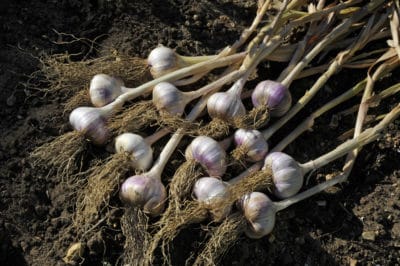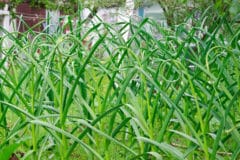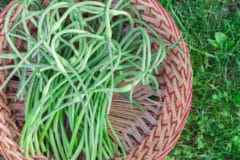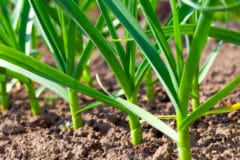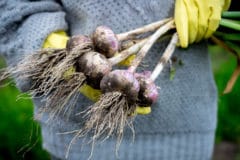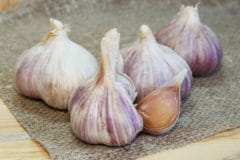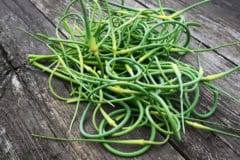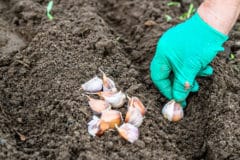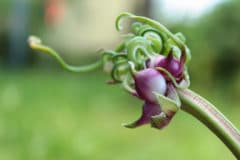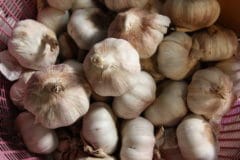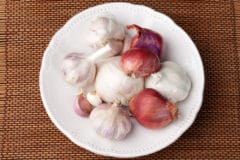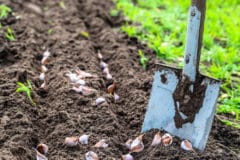What’s the Best Way to Grow Garlic?
Garlic does best in fertile, loose soil that holds water but also drains well. You can grow it in garden beds, a greenhouse or containers. In all cases, you must prepare the soil well ahead of time with plenty of well-aged manure, rotted leaves, and additional fertilizer such as bone meal or an organic 10-10-10 fertilizer. Regular watering is also key to growing good garlic.
Should I Plant Garlic in Spring or Fall?
When you plant garlic is primarily a matter of your climate. Although garlic is quite cold hardy, its season is so long that it may be difficult to plant in early spring when the ground is still frozen or very wet. Most cold-season gardeners plant garlic in late fall. It’s also better to plant garlic in fall in very warm climates. Temperate-area gardeners can choose spring or fall.
How Does Fertilizing Affect Harvest?
Proper fertilizing means healthy, well-grown garlic. Short garlic on nutrients and it won’t mature properly – and maturity may be considerably delayed. Inadequate nutrition also makes for smaller bulbs. Once harvested, the flavor of poorly nourished garlic may not be as good. On the other hand, too much nitrogen late in the season means excessive leaf growth – you’ll harvest smaller cloves.
How Does Watering Affect Harvest?
Garlic that is properly grown may remain in good shape for six to 10 months. To ensure plump cloves, you must keep the plant well-watered throughout the growing period. However, too much water once cloves have started to develop may push growth too hard. The cloves may begin to separate or even rupture. Once the leaves are well-developed and cloves have started to form, cut back on water.
When Should I Harvest Fall-Planted Garlic?
When growing fall-planted garlic, you must remember that there is a long period when the cloves are forming some roots but otherwise no growth is occurring. This period of semi-dormancy can add about two months to the expected maturity date. The plants won’t actually sprout until spring. If you plant in November, for example, you can expect to harvest garlic with a 90-day maturity around June.
When Should I Harvest Spring-Planted Garlic?
Weather may have some effect on garlic maturity with spring-planted garlic. However, garlic is very hardy, so late frosts are unlikely to actually damage the plants. However, a long rainy spring may slow drying. Published maturity dates are more accurate for spring-planted garlic, as there is no dormant period. For example, a 90-day garlic planted in March will be ready to harvest in late May or June.
Does It Make a Difference What Garlic I Plant?
You have the option to plant hardneck or softneck garlic (or both). Hardneck garlic sends up a strong central flower stalk several weeks before harvest. Softneck, as the name implies, only has soft leaves without a central stalk. Softneck garlic stores better. Hardneck garlic has fewer but larger cloves and does better in cold climates. You can also harvest the immature flower buds (scapes) from hardneck garlic and eat them.
What Are Good Garlic Varieties?
All garlic varieties have a unique flavor. They will also adapt to their locale and become subtly different from other plants of the same variety. Some well-known varieties include:
- Chesnok Red – purple striped hardneck, also known as Shvelisi.
- Susanville – softneck, good for roasting.
- Siskiyou Purple – softneck for hot climates.
- Spanish Roja – rocambole type, hardneck.
- Georgia Fire – a porcelain hardneck.
- Killarney Red – tolerates wetter climates.
Do I Only Harvest the Bulbs?
If you plant softneck garlic, you only harvest the bulbs. However, hardneck garlic sends up a flower stalk. The immature flower beds are called scapes. These can be harvested by cutting the stalk at the base. The scapes are edible and can be used in the same ways as garlic cloves. They can also be frozen, dried or pickled for storage and future use.
Why Do Scapes Matter When Harvesting Garlic?
Scapes matter for two reasons. First, as noted above they are edible, giving you two crops to harvest instead of one. Second, scapes offer a method of gauging the garlic’s readiness for harvest. Scapes usually appear about a month or six weeks before the cloves are ready to harvest. Even if you don’t want to eat the scapes, you should cut them off to encourage better clove development.
How Do I know When Garlic is Ready to Harvest?
In many cases, you can harvest garlic around the published maturity date (remember to add extra time for fall-planted garlic). You can also dig up a plant or two to judge clove development. Another way to gauge maturity is to watch for drying leaves. When about half the leaves have dried but the remainder are still green, your garlic should be ready to harvest.
What if I Harvest Too Early?
Garlic that is harvested too early will not be properly developed. The plants put most of their initial development into growing roots, then into growing leaves. Only when roots and leaves are well-developed does the plant begin to form cloves. Immature garlic isn’t a total loss, but it will probably not store as well and is unlikely to develop full flavor.
What if I Harvest Too Late?
Harvesting garlic too late can mean storage problems. Over-developed garlic will start to burst out of its tight wrapper and the cloves will begin to separate. Once this happens the garlic is more prone to develop moisture damage or even rot. Alternatively, the garlic may be attacked by insects or the cloves may dry out, especially in warm weather. The flavor may also be adversely affected and develop a bitter edge.
Can I Harvest Garlic Seed?
Hardneck garlic sends up a flower stalk and sets seed. Softneck garlic rarely has seed stalks. Garlic seed often doesn’t grow well. However, some people like to eat the seeds. Be warned, that if you let garlic go to seed, the cloves won’t be good to harvest in most cases. To harvest seed, wait until the paper flower heads dry, then crush over paper or a saucer.
Can I Leave Garlic in the Ground until Harvest?
Garlic is not a root crop, even though the parts we use grow underground. Think of it as a flowering bulb, like daffodils. If you leave it in the ground, the cloves will begin to split. They may rot in wet conditions. Eventually, the cloves will sprout and begin to grow again. However, they will be too crowded to make a good crop.
Does Weather Affect Garlic Harvest?
Cold, wet winters and springs may have some effect on garlic’s growth patterns, which could affect harvest times. Ideally, garlic should have limited water once clove development begins. Wet weather also makes it more difficult to harvest the plants. Wet weather also means it will be harder to dry (cure) the garlic after harvest. Improperly cured garlic will not store well and may rot or sprout in storage.
Exactly How Do I Harvest Garlic?
How you harvest depends on how many plants you’re dealing with. For just a few or for those grown in containers, you can use your hands – remove soil around the roots and pull up. Larger plots are best harvested with a garden fork as it is less likely to damage cloves than a shovel. Dig straight down next to plant and lever out of the ground.
What Care Does Garlic Need After Harvest?
Garlic needs a short drying period after it has been harvested. This is called curing. It gives the outside wrappers a chance to dry completely and tighten on the cloves, which facilitates storage. The best way to cure garlic is to hang in bunches of 10 to 12 plants in a dry, warm airy place. Curing garlic should be kept out of direct sun.
How do I Store Garlic After Harvest?
If you have a cool, dark, dry area, that’s an ideal place to store your garlic. You can hang the dried stalks or cut them off just above the cloves and store in a single layer in boxes. Garlic can also be frozen – peel, unpeeled, whole or chopped – or frozen in oil after being chopped or pureed. Finally, you can slice or finely chop the peeled cloves and dry in a dehydrator.
